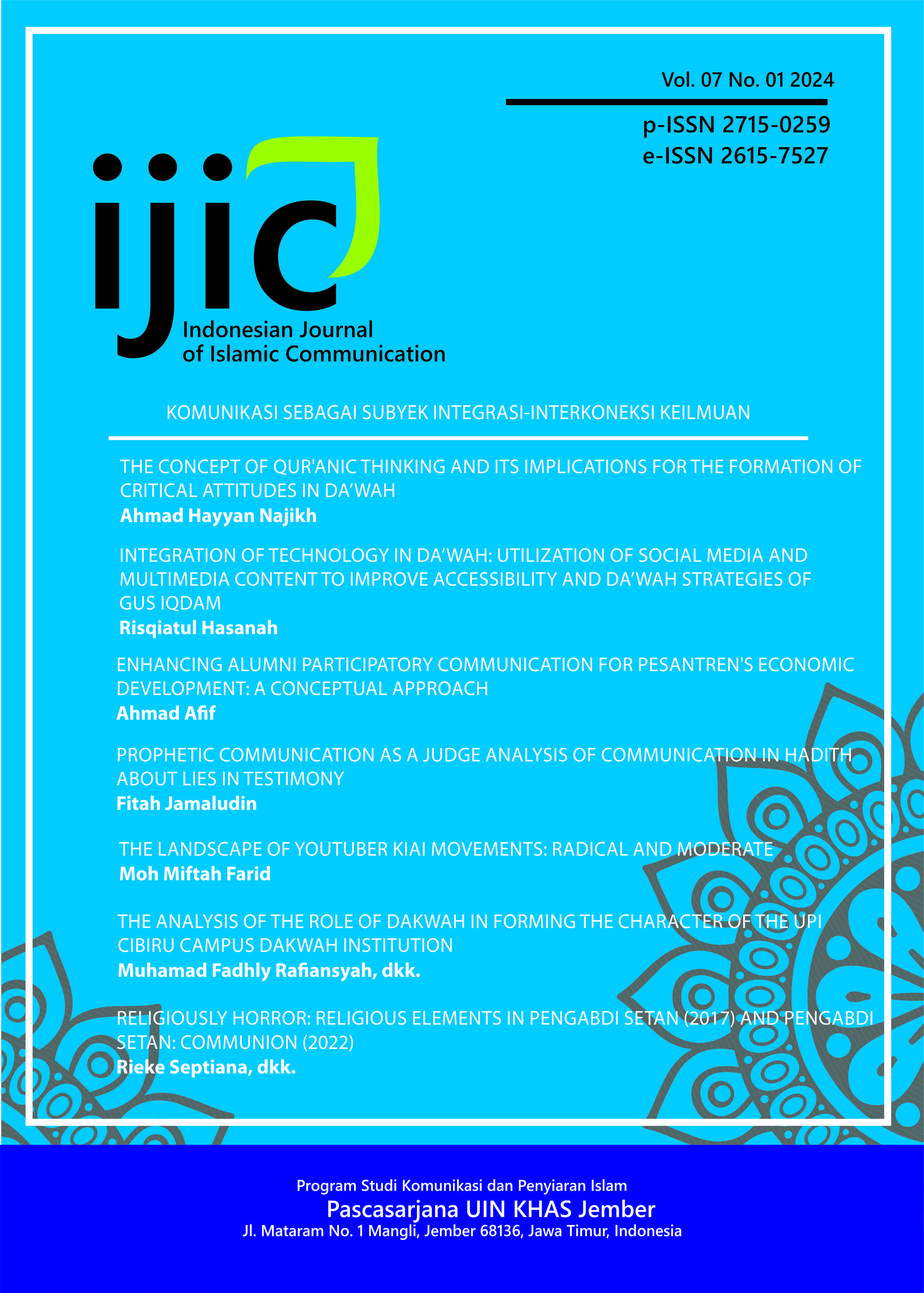RELIGIOUSLY HORROR: RELIGIOUS ELEMENTS IN PENGABDI SETAN (2017) AND PENGABDI SETAN: COMMUNION (2022)
DOI:
https://doi.org/10.35719/ijic.v7i1.2169Keywords:
Religious, horror, movies, predation, contagion, violation of personAbstract
This research explores the religious elements in the Indonesian horror movies ‘Pengabdi Setan’ (2017) and Pengabdi Setan: Communion (2022) using a descriptive qualitative approach, guided by Hank Davis and Javor’s religious horror theory (2004). The research explores how both movies incorporate religious elements from Islam and local beliefs to create a compelling horror narrative. Davis and Javor's theory, which examines the relationship between religion and the supernatural in horror, provides a framework for analyzing the moral and existential tensions between faith and evil forces. By focusing on the role of religious elements in shaping character behavior and plot development, the research highlights how these movies reflect broader societal concerns and spiritual struggles. The analysis reveals how religious elements intensify the horror experience, while also offering a deeper commentary on the complexities of faith, morality, and the battle between good and evil in Indonesian culture. This research is useful for future research, such as analyzing other genres such as horror comedy, based on the Hank Davis and Javor theory. This is also helpful in cultural, literary, and film studies by showing how religious elements can be used in horror to create stories that are both locally relevant and universal.
Downloads
References
as a Religious Prescription: The Raison D’être and Its Effect on the Industry.” Journal of Human Development and Communication Vol. 8 (2019): 41–48.
Adziz, A. C. A., Hashim, R., & Mustafa, H. (2015). The Influences of Empathy,
Depression, Anxiety and Stress on Supernatural Belief in Watching Horror Movies. Proceeding, 2nd International Conference on Media, Communication and Culture (ICMCC 2015), Theme: "ENGAGING SOCIETY THROUGH MEDIA AND COMMUNICATION,” 5.
Allen, Katherine. (2012). What Joy from Misery : the Pleasures of Horror. University of
East Anglia. https://ueaeprints.uea.ac.uk/id/eprint/42350/
Arapkirli, Bahar. “Religion Takes Over : A Retrospective Analysis of Turkish Horror
Genre.” ResearchGate Vol. No. (2017): 16-17.
https://www.researchgate.net/publication/320557028_Religion_Takes_Over_A_Retrospective_Analysis_of_Turkish_Horror_Genre
Aspers, P., & Corte, U. “What is Qualitative in Qualitative Research.” Springer Nature
Vol. 42 (2019): 139-160.
Boyer, Pascal. 2001. Religion Explained: The Evolutionary Origins of Religious
Thought. Basic Books, New York City.
Burgoon, J. K. 2015. Expectancy violations theory. The international encyclopedia of
interpersonal communication, New York City.
Davis, H., & Javor, A. 2004. Religion, Death and Horror Movies. Konrad Lorenz
Institute for Evolution and Cognition Research, Klosterneuburg.
Dreisbach, Gesine. “Using the theory of constructed emotion to inform the study of
cognition-emotion interactions. Springer Nature Link Vol. 30 No. 2 (2023): 489–497.
Edwards, Makayla. “Taking the ‘Psycho’ out of ‘Psycho-Killer’; The Impact of
Criminal Portrayals of Psychiatric Disorders in Horror Film.” Digital Literature Review Vol. 10. No. 1 (2024): 37–49.
Gong, Z., & Zhang, J. (2021). The 2021 3rd International Conference on Literature, Art
and Human Development. Proceeding, 3rd ICLAHD Theme: “REVIEW OF SOUND IN HORROR MOVIE,” 767–771.
Kaplan, R. D. 2023. The Tragic Mind: Fear, Fate, and the Burden of Power. New
Haven: Yale University Press.
Khairunnisa, A., & Wardhaningsih, Mira. 2020. A Book of Indonesian ghosts,
Independent Publisher, Yogyakarta.
Lamb, H. R., Lamb, H. R., & Weinberger, L. E. “The Shift of Psychiatric Inpatient Care
From The Shift of Psychiatric Inpatient Care.” The Journal of the American Academy of Psychiatry and the Law Vol. 33 No. 4 (2005): 531-533.
Minogue, Catherine (2024). “Shiver with anticipation; A study of suspense in the horror
film genre.” Institute of Art, Design and Technology. https://hdl.handle.net/10779/iadt.27038047.v1
Morton, N. C. (2023). A Phenomenon Investigation of Psilocybin Use Among The
Bereaved. ProQuest Dissertations & Theses. https://www.proquest.com/openview/b854ddd010974973bf9562d00fd7058a/1?cbl=18750&diss=y&pq-origsite=gscholar
Mubarok, A. N. “Tahlilan Tradition as Media for National Character Education.”
Journal of Nahdlatul Ulama Studies Vol. 2 No. 1 (2021): 1–16.
Nachbar, J., & Lause, K. (1992). Popular Culture: An Introductory Text, Bowling Green
State University Popular Press, Bowling Green.
Nevins, Jess. (2023). Horror Fiction in the 20th Century: Exploring Literature's Most
Chilling Genre, Wesport, Praeger.
Saputra, D., Ramasari, M., & Triyogo, A. “The Analysis of Religious Elements in The
Unholy Movie Directed by Evan Spiliotopoulus: Sociological Approach.” Publikasi Para Ahli Bahasa Dan Sastra Inggris Vol. 2 No. 5 (2024): 163–176.
Spradley, James P. (2016). Participant observation. Long Groove: Weveland Press.
Stone, Barbara. “The Sanctification of Fear: Images of the Religious in Horror Films.”
Journal of Religion & Film Vol. 5 No. 2 (2001): 41-56.
Suroyya, Dhama. “Commodification and Desacralication of Religious Symbols in
Indonesian Horror Movies.” IJIC: Indonesian Journal of Islamic Communication Vol. 1 No. 1 (2022): 15-38.
Tudor, Andrew. “Why Horror? The Peculiar Pleasures of a Popular Genre.” Taylor
and Francis Vol. 11 No. 3 (1997): 443–463.
Widodo, J. S. (2022). “The Representation of the Islamic Religious Leader in Film
‘Makmum’ by Riza Pahlevi.” Journal Albion: Journal of English Literature, Language, and Culture Vol. 4 No.1 (2022): 13–17.








